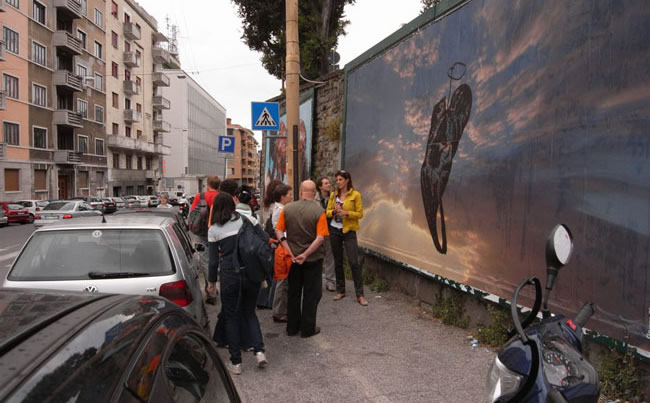To accommodate the tensile nature of fiber, Randy Walker seeks out frameworks that can act as looms, or creates his own, like this corncrib in Kalamazoo. “I scour my environment for suitable materials, like a spider trying to locate a site to build its web,” he explains. “These frameworks can be found objects like saw blades or window screens, or they can be architectural spaces, but they must be satisfactory structurally and sculpturally. I am, therefore, intensely engaged with the materials I use, studying them for cues as to how I might handle them. These armatures eventually define a working method for a particular piece.”
 This installation, Woven Corncrib, is part of the Western Michigan University (Kalamazoo) Sculpture Tour. National and international artists are commissioned to create and install work on the campus for two years. It was originally installed in Falcon Heights, Minnesota from 2004-9, using remnants of marine rope of various types. At WMU it was completely rewoven with a flat braid of 100% solution-dyed acrylic. The weaving process took two weeks of solid work. Although the installation will be up for two years, the braid material is expected to last much longer in terms of both color-fastness and material degradation.
This installation, Woven Corncrib, is part of the Western Michigan University (Kalamazoo) Sculpture Tour. National and international artists are commissioned to create and install work on the campus for two years. It was originally installed in Falcon Heights, Minnesota from 2004-9, using remnants of marine rope of various types. At WMU it was completely rewoven with a flat braid of 100% solution-dyed acrylic. The weaving process took two weeks of solid work. Although the installation will be up for two years, the braid material is expected to last much longer in terms of both color-fastness and material degradation.“For quite some time I have been interested in how fiber might be used in public artwork on large scales in a world where public art is predominantly seen by commissioning agencies as ‘permanent,’ ‘no-maintenance,’ etc. In other words: concrete, stone, steel,” Randy says. “While these more traditional materials are more permanent, even they need maintenance. Because there is often no funding or planning associated with maintenance of these “permanent” pieces, there are many around the country in states of decay. With the technological advances being made in fiber, and a fundamental shift in thought of what a work of public art could, I believe that it is possible to create art that has a planned maintenance, or regenerative potential. The Woven Corncrib is an example. It is re-woven, and a new piece is born from the old.”
Woven Corncrib, Western Michigan University, Kalamazoo, Michigan, photos courtesy of Randy Walker.





Stitch n’ B&#@%
Sometimes you just want to be mean. Resist the urge and stitch something sassy instead. Subversive Cross Stitch has lots of choices. From “whatever” to “Thanks for Sharing” and lots of “F”bombs in between.